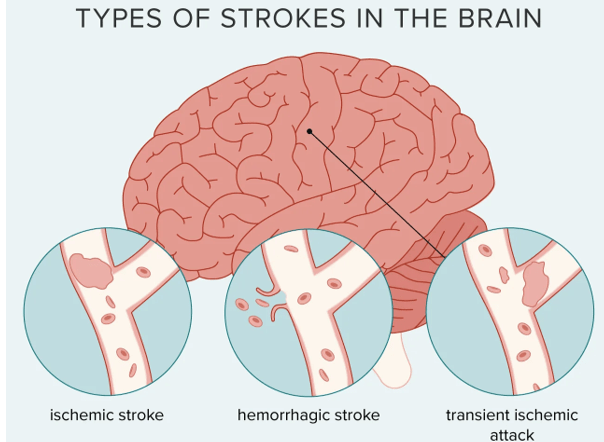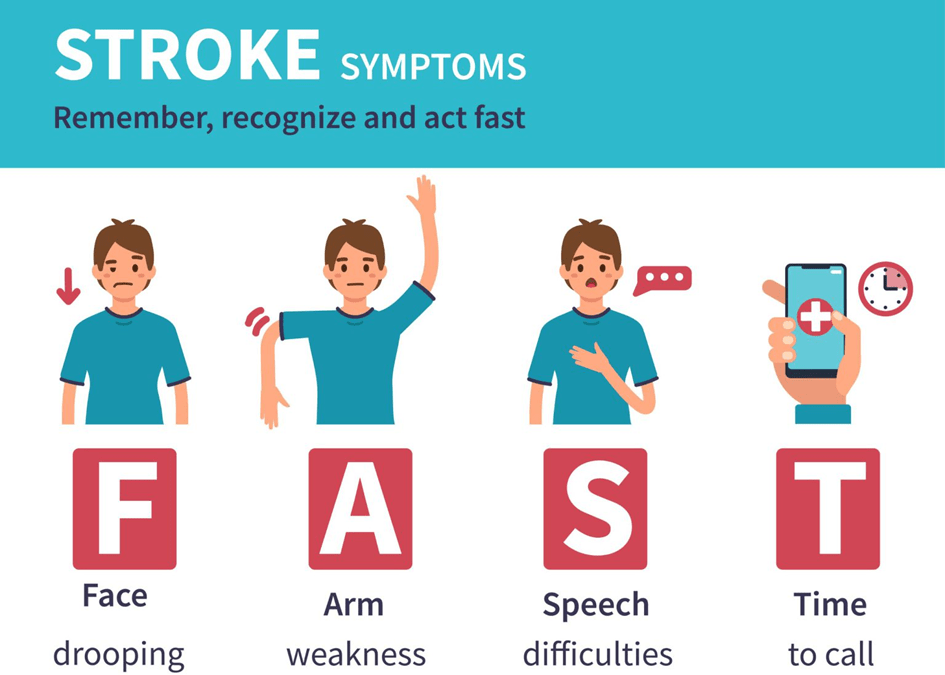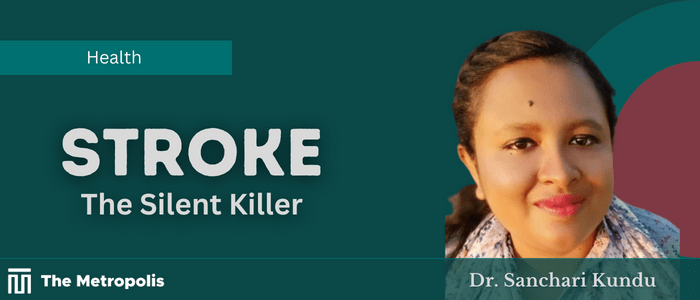Dr. Sanchari Kundu-
Stroke is a major health issue in Bangladesh, with a high incidence and prevalence rate. The World Health Organization (WHO) reports that stroke is Bangladesh’s second-leading cause of death and disability. Due to the young age of the affected population and the dearth of competent medical facilities in many regions of the nation, Bangladesh has a large burden of stroke.
A stroke is a cerebrovascular disorder that happens when there is a disruption or reduction in the blood flow to the brain, which results in the death of brain cells. Ischemic stroke and hemorrhagic stroke are the two primary forms of stroke. A brain blood vessel is blocked during an ischemic stroke by a blood clot, while a brain blood vessel ruptures during a hemorrhagic stroke.

Every 6 seconds, someone somewhere in the world dies of a stroke. Strokes were once thought to be a problem in rich countries only, but the number is higher in middle- and low-income countries.
Stroke is a serious and expanding public health issue in Bangladesh. More and more young people are developing the disease, and both the prevalence and age of start of stroke are rising.
A 2019 study found that, after cardiovascular diseases, stroke is Bangladesh’s second-leading cause of death. According to the study, stroke caused 9 percent of all fatalities in Bangladesh, with rates that were greater in rural than in urban areas. According to estimates from 2017, the age-standardized mortality rate (ASMR) from stroke was 64.3 per 100,000 people, or about 30 percent. Males are more likely to experience this (ASMR: 71.6 per 100,000) than females (ASMR: 57.6 per 100,000). Young and middle-aged adults make up the bulk of stroke victims in Bangladesh, which can have serious economic and social repercussions for individuals and families.
The Modified Rankin Scale (MRS) and the National Institutes of Health Stroke Scale (NIHSS) are two scales that can be used to assess the severity of a stroke in Bangladesh. By evaluating the level of consciousness, eye movement, facial palsy, arm and leg movement, ataxia, sensory loss, aphasia, and neglect, the NIHSS is used to gauge the severity of a stroke. The MRS is used to assess the level of reliance and disability following a stroke. A score of 0–2 denotes a favorable result, 3–4 a moderate disability, and 5–6 a severe disability.
According to a 2018 study, stroke patients in Bangladesh had an average NIHSS score of 13.5, which is indicative of a moderate to severe stroke. The study also discovered that among stroke patients, the mean MRS score was 4.2, suggesting substantial impairment. The study also found that men had more severe strokes than women, with a mean NIHSS score of 14.3 for men and 12.8 for women.
The severity of stroke in Bangladesh is influenced by several risk factors. Hypertension is one of the most important risk factors and is very common in Bangladeshi people. According to a 2017 study, hypertension affected 61.9 percent of Bangladeshi stroke patients. Obesity, smoking, and diabetes are additional risk factors. In Bangladesh, stroke patients were shown to have a diabetes prevalence of 21.2 percent and a smoking prevalence of 25.5 percent.
However, Bangladesh has several particular risk factors for stroke. Among these is the arsenic in drinking water issue, which is a major issue over much of the nation. Arsenic is a strong neurotoxin that can induce stroke and other cerebrovascular illnesses.
Other stroke risk factors in Bangladesh include the high incidence of obesity and overweight, particularly among women, and the use of smokeless tobacco, which is popular in some regions of the nation.
Another factor in Bangladesh’s high rate of strokes is the dearth of competent medical services there. Due to a lack of resources and qualified medical personnel, many stroke patients do not receive prompt and adequate medical care. As a result, stroke patients in Bangladesh experience significant rates of mortality and disability.
Due to scarce resources and a shortage of qualified healthcare workers, stroke management in Bangladesh is a significant concern. A recent study in the Journal of Stroke and Cerebrovascular Diseases found that the nation suffers from a severe lack of neurologists, stroke specialists, and rehabilitation specialists.
Furthermore, both the general public and medical experts are not well-informed about stroke. Many people in Bangladesh do not understand the signs of a stroke, and they are not aware of how crucial it is to get medical help right away.
Comprehensive stroke preventive and management methods are required to meet the rising stroke burden in Bangladesh. Public health activities to provide access to high-quality stroke care, as well as campaigns to increase awareness of stroke and its risk factors, should be included.
Additionally, Bangladesh’s healthcare system needs to be strengthened, especially in rural areas where access to healthcare is poor. This would entail setting up stroke centers in significant cities and educating medical professionals in the management of strokes.
The Bangladesh government has taken action in recent years to reduce the prevalence of stroke there. Aiming to prevent and manage non-communicable diseases like stroke, diabetes, and hypertension, the government introduced the Non-Communicable Disease Control Program in 2010. The program involves initiatives like health promotion, screening, and care, as well as the creation of recommendations for the treatment of non-communicable disorders like stroke.
In Bangladesh, primary and secondary prevention measures are used in the treatment of stroke. Primary preventative methods include dietary and lifestyle changes like quitting smoking, frequent exercise, and a nutritious diet. Utilizing antithrombotic medicines, managing blood pressure, and taking cholesterol-lowering medications are examples of secondary prevention measures. Due to a lack of funding and knowledge, these methods are only partially implemented in Bangladesh.
Effective care of stroke symptoms depends on early detection. The most typical signs of a stroke include sudden loss of vision, trouble speaking or understanding speech, and sudden weakness or numbness on one side of the body. The population is significantly underinformed about the signs and treatments of stroke in Bangladesh. Healthcare professionals and community health workers are essential in raising public awareness of stroke and urging people to get help right away if they have any symptoms.
In Bangladesh, a network of public and private hospitals offers emergency stroke care. The primary goals of acute stroke care are to stop further brain damage and improve blood flow. The type of stroke must be determined to establish the appropriate course of treatment. About 80 percent of strokes are ischemic strokes, which are brought on by blood clots that block brain blood vessels. About 20 percent of strokes are hemorrhagic strokes, which are brought on by bleeding in the brain.
Thrombolytic therapy, a medication that breaks the blood clot and restores blood flow to the brain, may be available to the patient if they get to the hospital within the first few hours of suffering a stroke. However, thrombolytic therapy necessitates specialized tools and qualified workers, and it is only efficient when given during the first 4.5 hours of a stroke. Unfortunately, Bangladesh has limited access to thrombolytic therapy because of expensive medicine, poor infrastructure, and a shortage of medical professionals.
The typical course of treatment for ischemic stroke in Bangladesh, in the absence of thrombolytic therapy, is supportive care, which includes rehabilitation and physical therapy along with drugs to regulate blood pressure and avoid blood clots. To stop the bleeding and relieve pressure on the brain, hemorrhagic stroke requires prompt medical intervention. Surgery can be required in some circumstances to get rid of the blood clot or fix the broken blood vessels.
Another crucial element of stroke treatment in Bangladesh is rehabilitation. It seeks to enhance the patient’s post-stroke physical, cognitive, and emotional functioning. Depending on the severity of the stroke and the patient’s development, rehabilitation should begin as soon as feasible after the stroke and may last for weeks, months, or even years.
Physical therapy and occupational therapy are all components of rehabilitation. Physical therapy focuses on regaining movement and coordination, whereas occupational therapy is concerned with everyday living activities including eating, dressing, and grooming. Patients who have trouble speaking or understanding language may also require speech therapy. To cope with the emotional and social impacts of the stroke, patients may also need psychological care.
The goal of long-term stroke care is to manage the patient’s ongoing medical requirements as well as to stop new strokes from occurring. This could involve taking drugs to lower cholesterol, blood pressure, and diabetes as well as making lifestyle changes including giving up smoking, eating well, and exercising frequently.
Additionally, stroke patients might need continued medical monitoring to catch any side effects like infections, cognitive deterioration, or repeat stroke. To assist them in taking care of the patient and preventing further strokes, family members and caregivers may also require support and education.

There are still major issues that need to be resolved in Bangladesh despite the attempts to enhance stroke management. The lack of qualified healthcare professionals, particularly in rural areas, is a significant problem. Additionally, there is a lack of public knowledge of stroke, which might make it harder for people to recognize their symptoms and seek treatment when they do. In addition, many patients, especially those from low-income families, may find it difficult to afford the high expense of stroke treatment.
Government and non-governmental groups in Bangladesh must collaborate to enhance access to care, raise public knowledge of stroke, and lower the cost of stroke treatment to solve these issues. This could entail actions like enhancing the availability of rehabilitation services, giving stroke sufferers financial aid and boosting the number of qualified healthcare professionals in rural areas.
Dr. Sanchari Kundu is a physician and activist.



